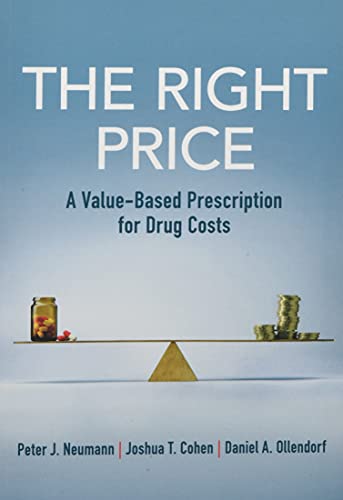Book Review: The Right Price

The book The Right Price: A Value-Based Prescription for Drug Costs is a fantastic book for individuals interested in understanding why value-based drug pricing makes sense. It is a bit more technical and more detailed than the average health policy book, but there are few formulas or detailed methodological explanations. Rather, the book provides a compelling argument and a great review of the literature on the benefits of and challenges of implementing value-based drug pricing. That the book should be able to so clearly elucidate these issues should not come as a surprise as the authors–Peter Neumann, Joshua Cohen and Daniel Ollendorf–are pre-eminent experts in value-based pricing methodologies for pharmaceuticals.
While the book covers a lot of group, I highlighted a few key excerpts I found of particular interest.
Are high drug prices a good thing?
High prices for brand-name drugs–rather than reflecting a policy flaw or “bug” in the system–is an expected and even intentional outcome. Monopolistic pricing is a system “feature,” designed to incentivize companies to invest in expensive and risky drug discovery by providing the prospect of a big payoff.”
The rise of orphan drugs
The Orphan Drug Act of 1983 aimed to promote the development of new drugs for rare diseases. But has the act been too much of a success?
In the 17 years prior to its passage, the FDA approved 34 orphan drugs versus 42 in the 7 years after enactment…In 2018, 58% of the novel compounds approved by the FDA had an orphan designation.
PBMs: The problem or the solution
Pharmaceutical benefit managers (PBMs) act as a middleman, using their size to help payers negotiate lower drug prices for their enrollees. However, it’s not clear whether PBMs are really making the market more efficient (the authors provide arguments both for and against PBMs in the book).
The Economist perhaps put it best in a recent piece, noting, “Everyone hates pharmaceutical firms, but their share of health-care rent-seeking is relatively trivial, especially once you include the many midsized and small firms that are investing heavily.” Some research has even shown that if one wants to find outsized profits in the healthcare industry, they tend to come from health insurers and PBMs, who face limited competition and low costs (e.g., PBMs have little to no physical plan or R&D costs), rather than drug companies. That analysis suggests the gain of insurers and PBMs represents two thirds of the excess profits in the healthcare industry per year.
The spread of HTA
Health technology assessment (HTA) actually began in the US, but formal, government-run HTA has never caught on in the US. Elsewhere in the world, however, HTAs are spreading.
Canada and Australia, for example, have long-standing health technology assessment (HTA) programs to assess the value of drugs and other technologies. A 2017 report found that of the 20 wester/southern European or Scandinavian members of the European Union or European Economic Area, 17 have at least one HTA organization with a national mandate to inform drug coverage, pricing and/or reimbursement. Although at earlier stages of implementation, HTA in eastern Europe has accelerated (a 2019 survey found that 9 of 13 countries in the region consider economic evaluation explicitly in drug coverage or pricing decisions).
Value is paramount, but payers have reasonable concerns about affordability
Sovaldi is an amazing treatment that basically cured individuals with hepatitis C. The price was high, but the huge benefits outweighed these cost. Despite being priced at a good value to payers and broader society, States and other payers struggled to pay for the treatment and ensure that the patients in need got access.
Five years after Sovaldi’s approval, 85% of hepatitis C-infected Americans still awaited treatment. In Louisiana in 2017 only 384 of the estimated 35,000 afflicted individuals on Medicaid or in prison had received treatment. According to the state’s Secretary of Health, treating the entire state population would cost $760 million, or “more than the state spends on K-12 education, Veteran’s Affairs, and Corrections combined.”
Should we get rid of the QALYs?
The authors describe the many of the limitations of using quality-adjusted life years (QALY), but the QALY’s ability to quantify a treatment’s impact on both mortality and morbidity and allow for comparison of treatment value across disease makes QALYs not the only way to do value-based pricing, but a very useful starting point. The titled one of the sections in Chapter 9 puts it best:
QALYs: The Worst Way to Measure Health, Except for All the Others.
The book discusses much more including using “dynamic pricing’ for cost effectiveness modelling, how broader value elements could and should be incorporated into cost effectiveness analysis, whether willingness to pay thresholds need to be adjusted when the societal perspective is taken, and–most importantly–whether value-based drug pricing should be a key driver of U.S. health policy for pharmaceutical (hint: the answer to the last question is ‘yes’).
Overall, it’s a great book for individuals who are interested in getting a comprehensive review of today’s drug pricing debate, and for better understanding how value-based pricing can provide a rational basis for drug pricing. Highly recommended.







